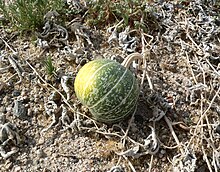| Cucurbita palmata | |
|---|---|

| |
| Conservation status | |
 Data Deficient (IUCN 2.3) | |
| Scientific classification | |
| Kingdom: | Plantae |
| Clade: | Tracheophytes |
| Clade: | Angiosperms |
| Clade: | Eudicots |
| Clade: | Rosids |
| Order: | Cucurbitales |
| Family: | Cucurbitaceae |
| Genus: | Cucurbita |
| Species: | C. palmata |
| Binomial name | |
| Cucurbita palmata S.Wats. | |

Cucurbita palmata is a species of flowering plant in the squash family known by the common names coyote melon and coyote gourd. It is similar to Cucurbita californica, Cucurbita cordata, Cucurbita cylindrata, and Cucurbita digitata and all these species hybridize readily. It was first identified by Sereno Watson in 1876. These species form the only restricted xerophyte species group in the genus Cucurbita. Each member of this species group is native to the Southwestern United States and Northwestern Mexico where they are relatively uncommon. Each group member is found in hot, arid regions with low rainfall. They prefer soil that is loose, gravelly, and well-drained. C. palmata is native to northeastern Baja California, southeastern California, and southwestern Arizona to a point near the Colorado River. The juvenile leaves of C. cylindrata, C. cordata, C. digitata, and C. palmata show a high degree of similarity, but their mature leaves are visibly different, as are their root structures. C. palmata and C. digitata are sympatric, with C. palmata separating the ranges of C. digitata at the juncture of Baja California, California, and Arizona. C. palmata fruits are diffuse green mottle that turns yellow at maturity, striped, and round.
Description
Cucurbita palmata is a sprawling vine with rough, stiff-haired stems and leaves. The dark green, light-veined leaves are sharply palmate with usually five long triangular points.
The stiff, curling yellow flowers are 6 to 8 centimeters wide. The plant bears smooth spherical or oblate squash fruits 8 to 10 centimeters wide.
The fruits may be bright yellow to dark green and may have white stripes. The rind is hard and thins with age. With a very bitter flavor the fruits are inedible, though Native Americans used them for soap and also ground the seeds to use as food. Dried gourds were also used as rattles for traditional dance ceremonies.
References
- ^ Nee, Michael (1990). "The Domestication of Cucurbita (Cucurbitaceae)". Economic Botany. 44 (3, Supplement: New Perspectives on the Origin and Evolution of New World Domesticated Plants). New York: New York Botanical Gardens Press: 56–68. Bibcode:1990EcBot..44S..56N. doi:10.1007/BF02860475. JSTOR 4255271. S2CID 40493539.
- "Cucurbita palmata". Germplasm Resources Information Network. Agricultural Research Service, United States Department of Agriculture. Retrieved September 14, 2013.
- Puchalski, J. T.; Robinson, R. W. (1978). "Comparative Electrophoretic Analysis of Isozymes in Cucurbita Species". Cucurbit Genetics Cooperative Report. 1. Raleigh, NC: North Carolina State University: 28.
- Bemis, W. P.; Whitaker, Thomas W. (April 1969). "The Xerophytic Cucurbita of Northwestern Mexico and Southwestern United States". Madroño. 20 (2). California Botanical Society: 33–41. JSTOR 41423342.
- University, Utah State. "Coyote Melon Gourd". extension.usu.edu. Retrieved 9 September 2024.
External links
[REDACTED] Media related to Cucurbita palmata at Wikimedia Commons
| Cucurbita | |||||||
|---|---|---|---|---|---|---|---|
| List of gourds and squashes | |||||||
| Species |  | ||||||
| Cultivars |
| ||||||
| Related topics |
| ||||||
| Taxon identifiers | |
|---|---|
| Cucurbita palmata |
|
This Cucurbitales article is a stub. You can help Misplaced Pages by expanding it. |
- IUCN Red List data deficient species
- Cucurbita
- Flora of California
- Flora of Nevada
- Flora of Arizona
- Flora of Baja California
- Flora of Sonora
- Flora of the California desert regions
- Flora of the Sonoran Deserts
- Natural history of the Mojave Desert
- Flora of the Sierra Nevada (United States)
- Plants described in 1876
- Squashes and pumpkins
- Cucurbitales stubs